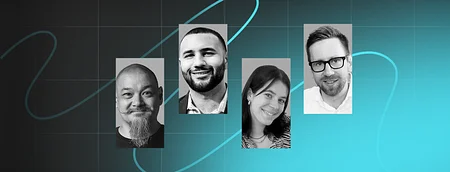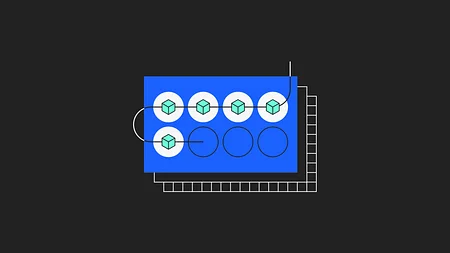Amber Baldet on Quorum, JPMorgan and when to use a blockchain
While at Money 20/20 in Las Vegas, Sam Maule, our Managing Partner of 11FS North America caught up with Amber Baldet, an Executive Director at JP Morgan, and the Programme Lead for Blockchain Centre of Excellence.
Amber leads the team at JP Morgan that’s developing Quorum, the opensource code based on Ethereum, that’s designed to address the specific challenges of blockchain technology adoption within the financial services industry.
So how is that [Quorum] going? If you were to look back at the lifespan of it, how are you feeling? Do you feel pretty good about it?
AB: Absolutely. I think it’s been an amazing feat, to opensource a codebase like this from a highly regulated institution. To figure out how to engage with the open-source community, and developers, how to get people excited about a project. How to, even, take pull requests from the public.
So, in a way, Quorum has certainly been a guinea pig project for what hopefully will be a much larger group of opensource projects over the years, that we’ll create.
I get really tired of, this hearing about how banks don’t understand fintech, or they don’t understand blockchain, and yet you’re giving a great example of the idea that we can do this. We can do opensource. That tends to go across what most people would think this would be approached.
I think banks get fintech. At this point, at least some people understand blockchain. I think even in the blockchain space, I think some people don’t understand blockchain!
The idea that banks don’t “get” it is probably a little bit outdated, but in the same turn, you get banks that say, “Well, fintechs don’t understand the business. They don’t get the ins and outs, and the underlying down in the weeds every day of what we’re really managing, and what we’re really dealing with, from, when you look at a business from end to end.
It’s easy to understand, and I’m guilty of this, as well, but when we talk about trade finance as an example of something you want to solve on the blockchain, it’s easy to say, in a perfect world, if we snapped our fingers, the entire finance supply chain, physical supply chain, or financial supply chain, would be on the blockchain tomorrow, but a lot of the proof of concepts we saw, early on, looked like, it was somebody’s Masters thesis or, somebody who went to Wikipedia and Googled, “What is trade finance?” and then you create a prototype.
So, it’s easy to dismiss things, based on those examples, but the market has matured so quickly, and we’ve seen, I don’t want to call it a brain drain, yet, at this point, but certainly a bunch of people with a lot of experience from the industry, who have been captured by this technology, who are now going and joining startups in the space. It’s a lot harder to make that argument when you’ve got somebody who has 20 years of supply chain experience across the table from you now. Certainly, the rate of evolution, and the maturity of the products that we see now is considerable.
You know, I actually think you have an advantage, too. When you work for Chase, when you work for JPMC like that, the scale at which they can operate in, is so important, right? That proof of concept. Let’s test it, right? You can tap into the expertise.
Sure, and you’re exactly right. The approach that we’re taking is, businesses need to have a transformation agenda, or a modernisation agenda, or a what are the next steps here for the business, and sometimes that includes blockchain, but it doesn’t necessarily have to. It’s about figuring out what are the tools in your toolkit to solve a business problem, and/or to hopefully make the client’s experience better when they interact with us.
So, what are the client’s pain points in interacting with this specific business? Is it really settlement time? Is it really trade breaks? Is it really just reporting is painful? Is it that it would be better to be able to have more of a breadth of liquidity management tools? I mean, there’s any number of challenges, or ways that we can approach making the client’s life better, and only some of those are solved with distributed ledger.
You have a quote I love, “Actual adoption of projects is what we really need when it comes to blockchain right now.”
Yes. I mean, we need real working, not just prototypes, but closer to production projects. There’s a fine balance between something that’s been running in production so long that it’s sticky and difficult to manoeuvre, and something that is so early stage that it’s difficult to ascertain what are the key success metrics, and are you actually achieving what you’re trying to achieve with the project?
I think within enterprise and banking specifically, we are relatively new to the idea of agile development, and dev ops, and all these things that are baked in to, quote on quote, you know, “Cloud native fintech”, kind of, applications. So, sometimes I like to make fun of us, in a way, where we have an emerging technologies platform that includes Cloud and API strategy, and I keep saying, “These things are not emerging technologies! They have emerged!”
At this point, this is just a modernisation strategy. We just need to actually start using the tech everyone else is. And so in that way, we need real projects, and not just projects, but use cases, business applications that are solving real problems, so that we can actually make a call, when we say it’s okay if four out of five prototypes fail. What is the success metric that you look at when you decide whether or not something is worth carrying forward? What is the real business problem or pain point that we’re trying to solve here?
In a much larger context, from a blockchain perspective, blockchain shines when it really captures a full value chain. The more comprehensive the use case or the application is, the more it makes sense, and you can see why you need a blockchain.
It doesn’t remove the incentive problem at all. It just changes the sort of incentives that people need. So, instead of just needing to be paid for your time, to validate blocks, for example, you need to be incentivised to need access to your counterparties. You want access to the liquidity of the market. You want to drive down your middle office cost. You want to completely revolutionise the way that, cybersecurity, or key management, or encryption, works within your institution. It’s a completely different sort of incentivisation model, but people don’t do things just because altruistically they want to see if the tech works. There’s got to be more to it than that.
You took over as the Blockchain Lead for Chase, in 2015? So, looking forward, lifespan-wise, does there come a point when you move on to something else?
Yeah, there’s so much going on right now. There are so many things that I would like to achieve, not the least of which being actual production code!
There’s a lot of things to do before we wave victory.
I might lead the product and strategy for JPM, and I might be our Disney Mascot of blockchain, but there’s an incredibly qualified and motivated team, both on the product side and the engineering side of JPM that, you know, I could get hit by a bus tomorrow, and it would continue on.
You know, that’s a good point, by the way. It’s so important to have that team behind you, right?
I mean, in curating the team, you hopefully ensconce some of those ideals in people, so that they would hopefully carry things forward in a way that you would have liked.
It’s really our job, in the Blockchain Centre of Excellence at JP Morgan, to try to be ahead of the curve, and to be disruptive, and to, ruffle a few feathers, and to challenge people, you know, why does your business exist as it does today?
Certainly there’s some organisational resistance, and getting in the door, and then there’s people that are very excited to whiteboard things, but then they’re like, “Great, we white boarded this. We’re done with it.” Then there’s other people that just become captured by it, and it’s about creating that spark. It’s about scaling the ideas, and the will to be transformative within the organisation. We certainly can’t do it alone, and we certainly can’t change a massive institution, like JP Morgan Chase, from a tiny office in Brooklyn. The best that we can do is to sit with people, and get them to bring their expertise in, and have them solve their own problems, but with these additional tools in their toolkit. And that’s what we work to do.
Listen to the interview in full or subscribe to Fintech Insider so you never miss an episode! Sam Maule is Managing Partner for the Americas. Connect with him on Twitter, LinkedIn or drop him an email. For more information about how 11:FS can help you with blockchain projects, visit our services page, contact us now or subscribe to Blockchain Insider to learn more about the industry.



